In one of my recent blogs, I focus on content creation and how incredibly important it is to be frequently posting interesting blog content, drafting curated social campaigns, etc. It’s true: Content creation is vital to the success of any strategic marketing plan.
But what if nobody sees it? What if the content you’re researching, writing, re-writing, pouring all this time and energy into–what if it’s all floating around the internet dodging your audience? Sometimes it may feel like your content doesn’t want to be seen. Although there are many ways to fix this, paid media is a great way to start.
Paid Media Defined
Hubspot calls paid media a method by which organizations can promote their content through sponsored social media posts, display ads, paid search results, video ads, pop-ups, and other promoted multimedia. Paid media can be a great opportunity to expand your brand reach, get more clicks, and generate more traffic.
Sounds simple, right? It is, but because it takes some level of strategy it’s important to fully understand the way it works. Let’s take a look at three types of media in the marketing world and the various forms of paid media available.
Earned, Owned and Paid Media
Using one of these three isn’t enough. Using a combination of earned, owned and paid media in your marketing strategy will help you entice, sustain and secure leads.
Earned Media
In short, earned media refers to exposure that your company has gained through word-of-mouth, SEO efforts, press mentions, positive reviews, etc.
Owned Media
To summarize, owned media is internal media coverage–it’s everything your company produces. Your website, your blog, and your social media accounts are all examples of owned media. This type of media emphasizes the importance of branded content creation. Let’s say you acquired leads through earned media; owned media will keep prospective clients interested and give them even more reason to use your services.
Paid Media
The media of the hour. Because it is becoming increasingly challenging to promote and advertise organically, it’s also becoming easier and easier to put a little money behind your efforts. For better or worse.
Twitter, LinkedIn, and Facebook all offer user-friendly advertising options that, when used correctly and purposefully, can draw eyes to the floating content dodging your desired audience.
Examples of Paid Media
There are a wide variety of Twitter ad campaigns to choose from–each designed to meet a specific need. Whether you want to increase awareness, engagement rates, follower counts, or website clicks, Twitter offers the campaign you need. After setting your objective, you have the opportunity to choose your target audience, bid on the cost per interaction, and then pick which tweet(s) to sponsor. These paid ads will then be placed on users’ Twitter feeds, search results page, promoted trends, or through official Twitter advertising partners.
With LinkedIn, you can sponsor content or updates that will appear in users’ feeds. After setting a budget for each campaign, you’re able to target users based on interest, industry, and job title. At this point, you can then present a link to a landing page with the content you desire to promote.
Sponsored InMail is also available, which uniquely allows advertised content to show up in users’ Messaging feature. The InMail advertisement only appears when the user comes online–grabbing their attention immediately.
Facebook offers multiple paid media opportunities. These options follow a similar process as Twitter and LinkedIn–the objectives, target audiences, and budgets are all customizable. Firstly, single-spaced ads are available to purchase and promote on users’ news feeds. In addition, carousel ads allow you to incorporate multiple photos into a single campaign. While the home page is a great spot to put your Facebook ads, Facebook Marketplace, Facebook Suggested Video, Facebook Right Column, and Messenger Inbox are also available spaces for ad placements.
-Written by Lily Tillman
